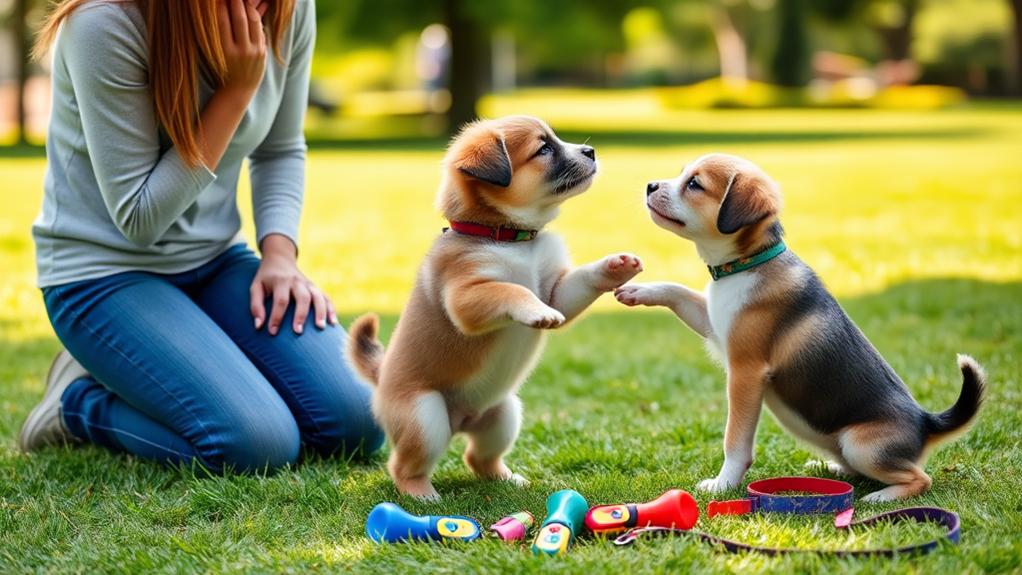To guarantee a happy, well-behaved puppy, focus on five essential training guides. Start with positive reinforcement techniques, rewarding good behavior with treats or praise. Next, teach basic commands like "sit," "stay," and "come" for better control. Don't forget socialization; introduce your puppy to new people and pets to help them adjust. Crate training is also critical; make the crate a safe retreat, not a punishment. Finally, address common behavioral issues like barking and chewing early on. These foundations will set your puppy up for success, and there's plenty more to explore for lasting results.
Positive Reinforcement Techniques
Utilizing positive reinforcement techniques can make training your new puppy both effective and enjoyable. This approach focuses on rewarding your pup for desirable behaviors instead of punishing them for mistakes. When you catch your puppy doing something right, like sitting or coming when called, offer a treat, praise, or a favorite toy immediately. This encourages them to repeat those actions.
Consistency is key. Make sure everyone in your household uses the same commands and rewards to avoid confusing your puppy. It's also essential to keep training sessions short and engaging. Puppies have short attention spans, so aim for 5-10 minute sessions a few times a day.
You'll also want to be patient. Puppies are learning about their world, and they won't grasp everything immediately. Celebrate small victories, and don't hesitate to adjust your techniques if something isn't working. If a behavior isn't improving, rethink your reward strategy—sometimes, a different treat or toy can make all the difference.
Basic Commands to Teach

Teaching basic commands is essential for a well-behaved puppy and helps establish a strong bond between you and your new furry friend. By teaching commands like "sit," "stay," and "come," you lay the groundwork for effective communication. Here's a simple table to guide you on these commands:
| Command | Purpose |
|---|---|
| Sit | Helps control jumping and encourages calm behavior. |
| Stay | Teaches patience and keeps your puppy in one spot. |
| Come | Facilitates your puppy's return to you, promoting safety. |
To start, use positive reinforcement—praise or treats—whenever your puppy successfully follows a command. For "sit," hold a treat above their nose, moving it back over their head. As they sit, say "sit" and reward them. With "stay," ask your puppy to sit first, then take a step back while saying "stay." If they remain in place, reward them immediately. For "come," call your puppy excitedly while backing away, encouraging them to approach you. Consistency and practice are key, so make training sessions short and fun!
Socialization Strategies for Puppies
Socialization is essential for your puppy's development, helping them become a well-adjusted and confident adult dog. To guarantee your puppy grows into a friendly and adaptable dog, you'll want to expose them to a variety of experiences, people, and environments.
- Introduce New People and Animals: Regularly meet friends, family, and other pets. This teaches your puppy to be comfortable around different beings.
- Visit Various Environments: Take your puppy to parks, busy streets, and pet-friendly stores. These experiences help them acclimate to different sounds and sights.
- Enroll in Puppy Classes: Consider signing up for a puppy training class. It's a great way for your puppy to interact with other dogs while learning basic commands.
- Use Positive Reinforcement: Reward your puppy for calm behavior in new situations. This reinforces their confidence and encourages good behavior.
Crate Training Essentials

Crate training can be a valuable tool for both you and your puppy, providing a safe space for them to relax and feel secure. Start by choosing the right crate size—one that allows your puppy to stand, turn around, and lie down comfortably. Introduce the crate gradually. Place it in a common area and encourage your puppy to explore it by using treats or toys.
Make the crate a positive experience. Feed your puppy near the crate or toss in their favorite chew toy. Never use the crate as a punishment; it should be a retreat, not a place of fear.
Begin with short periods of confinement, gradually increasing the time as your puppy adjusts. Monitor them closely during this process. If they whine, wait a moment before letting them out; they may just be settling down. Consistency is key; establish a routine for crate time, especially at night or when you're away.
Dealing With Common Behavioral Issues

As your puppy settles into their new crate, you may start noticing some common behavioral issues that can arise during this critical adjustment period. It is crucial to address these problems early on to foster a well-behaved companion. Here are four common issues you might encounter:
- Barking: Excessive barking can indicate anxiety or boredom. Provide toys and gradually increase crate time to help them adjust.
- Chewing: Puppies love to chew, and they might target the crate. Offer appropriate chew toys to redirect this behavior and discourage crate chewing.
- Potty Accidents: Accidents can happen, especially if your puppy isn't fully house-trained yet. Establish a routine for potty breaks and reward them for going outside.
- Separation Anxiety: If your puppy whines when you leave, they might struggle with separation. Start with short departures and gradually extend the time apart to build their confidence.
Conclusion
In summary, by using positive reinforcement, teaching basic commands, and prioritizing socialization, you're setting your puppy up for success. Remember to make crate training a positive experience, and address any behavioral issues with patience and consistency. With these essential guides, you'll create a strong bond with your furry friend while ensuring they grow into a well-adjusted adult dog. Enjoy the journey of training together, and don't forget to celebrate those small victories along the way!



